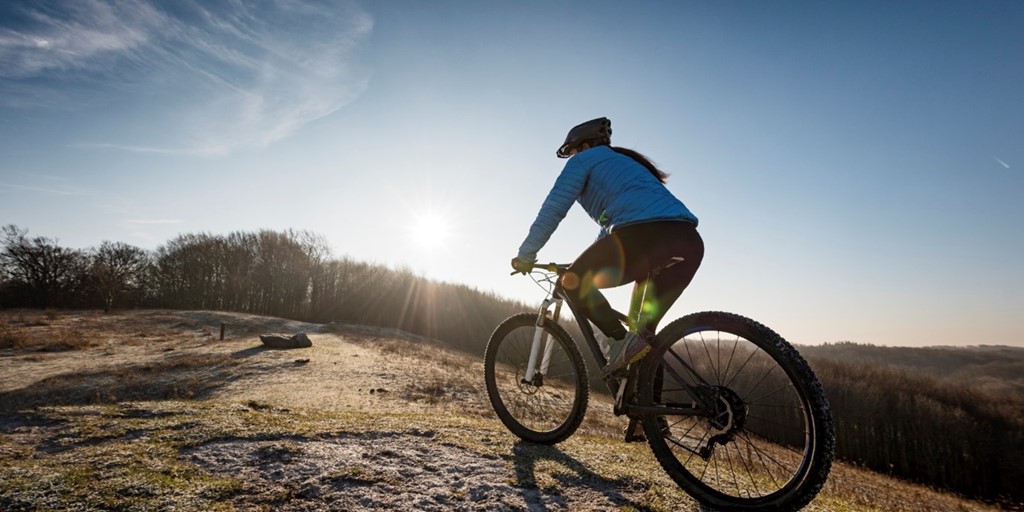What to wear when cycling in cold weather
04 February 2021

We’re sure you don’t want to pack your bike away and hibernate for the season whenever winter rolls around. Fortunately, there’s a range of lightweight, high-insulating, and high-wicking cycling clothing to keep you warm when cycling in cold weather. Let’s look at some essentials.
Table of contents
- Cycling thermals
- Bib shorts or leggings
- Cycling jersey or t-shirt
- Arm and leg warmers
- Bodywarmer
- Jacket (waterproof)
- Gloves
- Neck warmer
- Hat
1. Cycling thermals
Cycling thermals are the most crucial layer when preparing for cycling in cold weather. They provide a high base level of insulation before you add your other garments. Without them, the capacity for your other clothing to keep you warm will be severely limited.
Thermals can take the form of leggings or long-sleeve tops that fit tightly to your skin. They’re made from synthetic materials designed to draw sweat away from your body while also retaining warmth. Without those ventilative properties, you might be warm but soaking through with sweat, which doesn’t make for a comfortable ride. Not to mention, you might catch a chill if your wet skin is exposed to the cold air.
2. Bib shorts or leggings
Again, we’re opting for thin and lightweight here, so you’re keeping wind resistance and bulkiness to a minimum. For this reason, bib shorts or leggings are the logical next layer. They’ll keep your legs and arms covered while clinging to your skin, which takes the bite out of the cold air.
Long-sleeved and long-legged versions are best. However, some winter days are milder than others, so you could get away with shorts and short sleeves at times.
These bib shorts or tights don’t need to be anything special. You might want to invest in thicker ones for the winter, but if you layer up properly with everything else, you should be able to use your normal ones.
3. Cycling jersey or t-shirt
Whether you use a T-shirt or a high-wicking cycling jersey, this layer is quite straightforward—just wear something over your thermals and under your jacket. The lattice effect of the materials on top of each other will insulate the heat and add another layer of protection between your body and the outside atmosphere.
There are more layers to add to your cycling jersey or t-shirt, so you can’t go wrong. That said, long sleeves will give you better coverage.
4. Arm and leg warmers
Arm and leg warmers are purpose-made for colder weather. They’re highly insulating, elasticated sleeves made from high-wicking synthetic material. Quite often, they’re also waterproof.
These garments are well worth having in your backpack when you ride in cold weather, even if you don’t wear them from the start. They’re lightweight and fold down small, so you can put them on or remove them as the weather permits.
5. Bodywarmer
While these layers offer a myriad of benefits, they can also limit mobility, which is why it’s important they’re thin. A bodywarmer, however, circumvents this because it’s sleeveless, meaning it’ll insulate your body without further impeding your arms by wrapping yet another sleeve around them.
Bodywarmers tend to be fleece or nylon and are a central part of properly insulated cold-weather cycling gear.
6. Jacket (waterproof)
As with most garments in this article, you might want to mix and match depending on the weather conditions. You could opt for a jacket straight over your cycle jersey or t-shirt, or layer it with a bodywarmer. For truly cold conditions, you’ll want as much protection as possible, so we recommend both options.
Wind—and rain-resistant materials, as well as lightweight and high-wicking ones, are most suitable for cold-weather cycling. It’s also important to invest in a jacket with reflective material so you’re more visible at night and on muggy, overcast days. Failing that, you may want to buy some reflective strips separately.
7. Gloves
Between the air whipping over your knuckles and the chilly temperatures, you’ll feel it if you go out on a cold-weather ride without gloves.
Cycling gloves usually come with two options – fingerless or with full coverage. Although fingerless gloves don’t keep your hands fully insulated, they do afford better dexterity. You can assess which type of glove is most suitable based on the weather forecast. On the plus side, many full coverage cycling gloves come with rubber grips on the fingertips to maintain effective braking and grip.
8. Neck warmer
The neck warmer—the more evolved cousin of the scarf—is ideal for cycling in cold weather because it does not require tying or maintenance. It’s literally a looped piece of fleece fabric that you squeeze over your head (and sometimes tighten at the base using a drawstring toggle).
A neck warmer protects your body from draughts that might enter via the opening at your collar. It will also keep your neck and lower face shielded from the elements.
9. Hat
Sometimes you can’t improve on the classics, so get a trusty warm beanie or skull cap that fits under your helmet. Just using the helmet itself can prove a bit too chilly, especially as you sweat.
Specialist cycling insurance through Cycleplan
If you’re the type of person who cycles even during the winter months, cycling must mean a lot to you. For that reason, you may want to get insurance to keep yourself, your bike, and your bicycle accessories protected while you ride.
Specialist cycling insurance through Cycleplan offers cover for damage (accidental and third-party), loss, and theft of your bike and cycling equipment, whether you’re at home or on a ride.
Learn more about specialist cycling insurance or get a quick online quote today.
Please note the information provided on this page should not be taken as advice and has been written as a matter of opinion. For more on insurance cover and policy wording, see our homepage.
